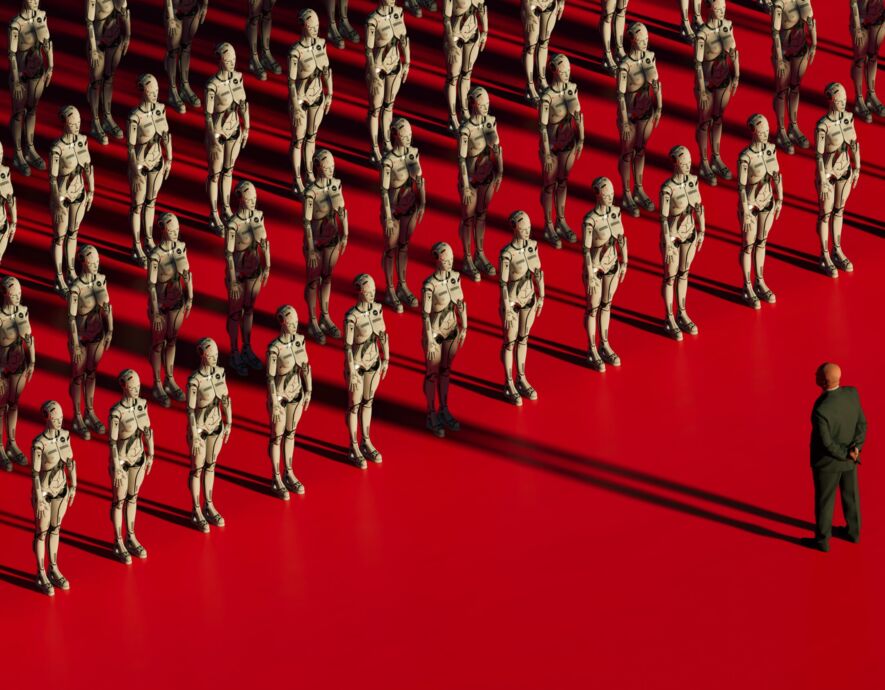
- Home
- Digital transformation
- “Cyberpunk: Edgerunners”: an anime series that treats the human body like any other product
“Cyberpunk: Edgerunners”: an anime series that treats the human body like any other product


Inspired by the “Cyberpunk 2077” video game, this series is the chronicle of a disaster foretold in a world where all the fine technocentric ideas seem to have become the stuff of nightmares.
At first sight, this series could be misleading. Anyone who grew up with “Les Chevaliers du Zodiaque” or “Dragonball Z” will notice that “Cyberpunk: Edgerunners” uses the same visual codes. But don’t be fooled. The topics covered and the images that portray them are aimed at an informed public.
That said, it is worth taking the time to describe the world of “Edgerunners”, because it is a highly instructive exercise. The series is set in 2077, where we discover a hyperurban environment dominated by steel, glass and concrete, in which vegetation is conspicuous by its absence. The only sequence that takes place outside the city reveals a desert.
For its part, the society depicted in the series is shaped by a rampant liberalism which, while allowing citizens to hope for the best, makes every achievement a hard-fought victory against adversity and widespread social competition. Nothing there can ever be taken for granted. Failure waits patiently for its opportunity to strike, dragging down anyone who commits even the slightest mistake. In the underbelly of this titanic city, the fallen are legion. Alcohol and drugs are all the sole remaining solace in their sordid daily lives.
But there is another side to this futuristic society: for those who have the (financial) means, nothing seems out of reach. This is all the truer since these same resources enable people to augment their bodies and enhance their human nature with prostheses or biomechanical extensions. Added to this is the fact that the prevailing climate of extreme liberalism allows access to these prostheses, whether they are official or under the counter, new or second-hand. This same rampant liberalism encourages all kinds of trafficking.
Biomechanical enhancements: between reality and fiction
Biomechanical or software enhancements are at the heart of this series. But what are they, exactly? They are means of communication: smartphones have been replaced by different types of implants: cochlear (hearing) and sclerotic (sight), which are controlled by thought. They are means of knowledge and the generalization of an idea proposed by a certain Elon Musk: making all human knowledge immediately available to everyone by means of a human-machine neurological interface (a computerized device that enhances an individual’s cognitive functions).
During our time, surgeons (professionals) have been amongst the first to use these means of enhancing movements. Disabled people are now also starting to benefit from them. Such prostheses, in the form of complete or partial exoskeletons and other variants, are set to become widespread in many fields, in the relatively short term. It should be noted that these enhancements, which are approaching a form of maturity, are envisaged and accepted within a healthcare context, i.e., for the restoration or repair of a deficient organic function such as a motor or neurological paralysis, an accidental amputation, or a congenital malformation.
Prospects that are revolutionizing medical ethics
Everything mentioned above is within reach, even if many scientific and technological steps still need to be taken before these prosthetic extensions become widespread, functional products. Once these technical steps have been completed, which will be in the short, medium or long term, to the delight of the most enthusiastic advocates, the ethical dimension will then need to be considered.
This concerns the transition from the notions of healthcare and professional enhancement to those of comfort, leisure and the freedom to exercise control over one’s body, with the question of reversibility always present in the background. The situation could be summarized as a shift from the “sacred body” to the “commercial body” because the market for prostheses is lying in wait, or at least this is the premise of “Edgerunners”.
In France today, the medical profession applies a principle summed up in the Latin phrase “Primum non nocere”: “first, do no harm” (to the patient). By extension, this injunction can be interpreted as including the notion of reversibility. Outside of any medical indication, any action must remain reversible.
In “Cyberpunk: Edgerunners”, reality leaves no room for such precautions. One might even say that a further step has been taken. Here, the biological body seems devoid of any soul. It has become an object like any other that can be amputated – almost wholly or partially – and replaced by a prosthesis that provides an additional or superior function in relation to the replaced organ.
Chronicle of a disaster foretold
Having outlined the contours of this futuristic society, all that remains is to follow the destiny of David, the hero of this series. Born into a lower middle-class family, his mother works long hours to offer him a bright future. This includes paying for his education in a private institution. It is difficult to make ends meet. Sometimes she has to choose between paying the rent and paying for academic software updates.
The boy is resourceful, however, and finds a way around this by turning to the black market for software. which becomes a necessity as his fellow students are from rich and powerful families. This gives them access to a wide range of improvements or enhancements which, from today’s perspective, undermine academic equality within classes.
The story soon takes a dramatic turn when our hero finds himself in situations in which the enhancements he deems necessary for his survival are based solely on software. He moves on to body enhancements. Caught between a morbid fascination with novelty and a strange twist on the Jevons paradox applied to prostheses, the portion of his biological body constantly diminishes in favor of biomechanical prostheses.
But David is not the only one to engage in this strange practice. Some of his friends are predominantly artificial. All that remains of their human nature, so to speak, is their brain. These practices are associated with a risk of “cyberpsychosis”, which is a consequence of the psychic struggle between one’s biological nature and the artificial portion of one’s body, with the mind no longer knowing which reality to side with.
Whether this cyberpsychosis is an objective disorder or otherwise is irrelevant. This is a work of fiction. It does, however, prompt the question: when I replace 5, 10, then 20… followed by 40 or even 80% of my body with prostheses, do I remain the same person? Is there a point at which the augmented “self” proves to be different from the biological “self”?
Humanity and cybernetics
There are two perspectives on this issue. The first consists in reducing the human person to the 1.4 kilograms of grey matter contained in the cranium. From this perspective, the body is merely a vehicle for the personality. The artificial portion of a human body becomes insignificant. What counts is the brain, which – according to transhumanists – we will one day be able to digitalize.
The other perspective takes account of the latest complex research, which reveals that the presence of neurons is not limited to the cranium. They are also found in the spinal cord, in the heart and around the intestines. An individual’s personality therefore seems to be the result of a precise, complex interaction between an inner “self” and the experience of the outside world acquired by an individual through his or her body. Modifying this body means modifying the “experiential self”.
All these nuances explain the observers’ sadness at witnessing David’s inevitable downward spiral. These same observers are also entitled to feel sickened by the rampant liberalism in the world of “Edgerunners”, which crushes individuals in pursuit of profit. They may even shed a tear when David’s love affair collides head-on with the unyielding walls of cybernetic reality; but above all, we first need to look to our present to question the applications that are being prepared for technologies which, while representing miracles for some, still pose a number of questions that need to be answered before their use is authorized outside of medical or professional circles.
the newsletter
the newsletter



